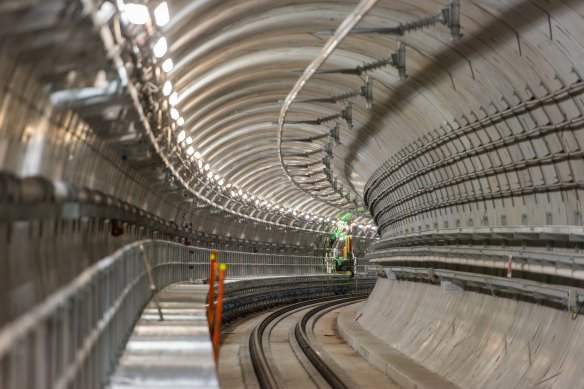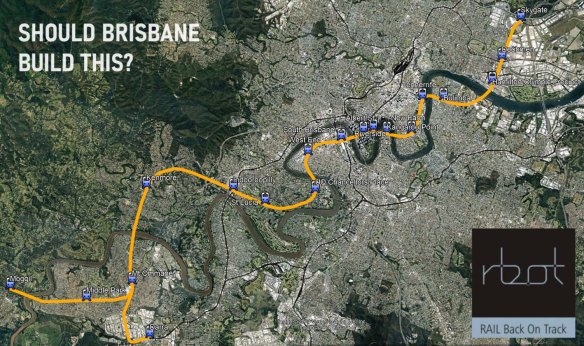This was published 9 months ago
Public transport advocates rail against road tunnel proposal
The state government has been urged to abandon a Centenary Motorway tunnel bypass proposal in favour of old plans for a high-frequency rail line under Brisbane’s western suburbs through to the airport.
Public transport advocate Robert Dow, from Rail Back on Track, said the proposed Centenary tunnel – along with other road projects such as the “second M1” Coomera Connector – came at the expense of public transport projects.
Central among those was the seemingly abandoned Brisbane Subway, which would have linked western suburbs to the airport, via West End, the CBD, Newstead, Bulimba and Hamilton.

Construction of the new Roma Street Cross River Rail Station in July. Brisbane Subway passengers would change platforms to access these lines.
The subway formed part of the Bligh government’s Connecting SEQ 2031 plan in 2011, but has not featured in public-facing communications since.
Dow, who described the subway as a “game changer”, said a road tunnel would not have the bang-for-buck a heavy rail metro tunnel would deliver westside residents.
“If you spend $20 billion on metro systems, you’ll have a gold asset – it’s going to last forever and it’d be able to move 50 times the people and that’s what you’re going to need in Brisbane,” he said.
Rail Back on Track’s vision for the Brisbane Subway would extend as far west as Moggill and Darra.

Rail Back on Track’s proposed Brisbane Subway route.Credit: Rail Back on Track
While the Bligh Labor government said the subway would support “major growth in the inner city”, Transport Minister Bart Mellish said the current Labor government’s focus was elsewhere.
“The Miles government’s priority for south-east Queensland is to provide transport options for growing communities, particularly those in the greater Brisbane area,” he said.
“This includes projects like the Gympie Road Bypass tunnel, Cross River Rail, the newly proposed Centenary Tunnel, Sunshine Coast Direct and Logan and Gold Coast Faster Rail.”
But one of Mellish’s predecessors, former Labor deputy premier Paul Lucas, said the Brisbane Subway should be on the government’s long-term agenda.
“It connects things that are not yet properly connected to the transport network. The UQ busway was revolutionary – a railway line underneath it would even be more so,” he said.
“The Bulimba peninsula is being loved to death. It is way beyond the limit of cars and there’s still development happening there.”
Lucas said because it would be separate from the rest of the rail system, the subway could be fully automated, like the newly operational Sydney Metro.
Subway passengers could alight at integrated stations, where they could board Citytrain, Brisbane Metro or bus services above the subway platforms.
While Lucas conceded it would not come cheap, he said surface activations meant it could attract private funding.
“Tunnelling is reasonably inexpensive compared to on the surface,” he said.
“The disturbance to a large city is infinitely less and it gives you the opportunity to develop [on the surface] – I think when Cross River Rail is finished, people will be astonished, not just by what the railway line is, but by the buildings that are then facilitated around it.
“That property around Albert Street [CRR station] will go off like hotcakes.”